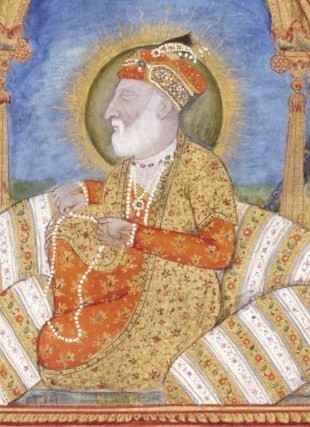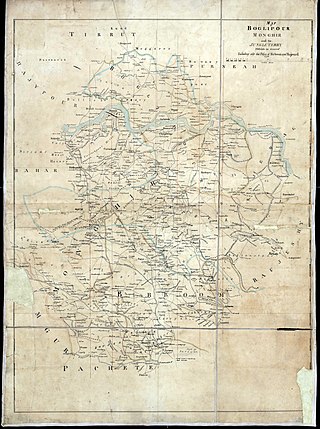Related Research Articles

A zamindar in the Indian subcontinent was an autonomous or semiautonomous ruler of a province. The term itself came into use during the reign of Mughals and later the British had begun using it as a native synonym for “estate”. The term means land owner in Persian. Typically hereditary, from whom they reserved the right to collect tax on behalf of imperial courts or for military purposes. During the period of British colonial rule in India many wealthy and influential zamindars were bestowed with princely and royal titles such as maharaja, raja/rai (king) and nawab.

Shah Alam II, also known by his birth name Ali Gohar, was the seventeenth Mughal Emperor and the son of Alamgir II. Shah Alam II became the emperor of a crumbling Mughal empire. His power was so depleted during his reign that it led to a saying in the Persian language, Sultanat-e-Shah Alam, Az Dilli ta Palam, meaning, 'The empire of Shah Alam is from Delhi to Palam', Palam being a suburb of Delhi.

Man Singh I, popularly known as Mirza Raja Man Singh was the 29th Kachwaha Rajput Raja of Amer, later known as Jaipur state, in Rajputana. He was the most powerful and trusted general of the Mughal emperor Akbar, who included him among the Navaratnas, or the nine (nava) gems (ratna) of the royal court of Akbar. Man Singh fought sixty-seven important battles in Kabul, Balkh, Bukhara, Bengal and Central and Southern India. He was well versed in the battle tactics of both the Rajputs as well as the Mughals.
Muslim Rajputs are the descendants of Rajputs in the northern regions of the Indian subcontinent who are followers of Islam. They converted from Hinduism to Islam from the medieval period onwards, retaining Hindu surnames such as Rana and Chauhan. Today, Muslim Rajputs can be found in present-day Northern India and Pakistan. They are further divided into different clans.
The Darbhanga Raj, also known as Raj Darbhanga and the Khandwala dynasty, was a Maithil Brahmins dynasty and the rulers of territories, not all contiguous, that were part of the Mithila region, now divided between India and Nepal.
Bhumihars, also called Babhan, are a Hindu caste mainly found in Bihar, the Purvanchal region of Uttar Pradesh, Jharkhand, the Bundelkhand region of Madhya Pradesh, and Nepal.
The region have been inhabited since the Stone Age. Copper tools from the Chalcolithic period have been discovered. This area entered the Iron Age during the mid-2nd millennium BCE.
Hathuwa Raj was a chieftaincy belonging to Baghochia dynasty of Bhumihars. It encompassed 1,365 villages, was inhabited by more than 391,000 people, and produced an annual rental of almost a million rupees It was located in the Saran Division of Bihar. Earlier seats of the Raj included Huseypur, Kalyanpur, Balchowra and Baghoch. The Kalyanpur chieftaincy was subjugated by the Mughal Emperor Akbar during late 16th century.

Tekari Raj was a zamindari estate belonging to a family of the Bhumihar Brahmin community in South Bihar. They controlled 2,046 villages on their estate, which covered a 7,500 square kilometres (2,900 sq mi) area, near to the town of Gaya.

The Zamindars of Bengal were zamindars of the Bengal region of the Indian subcontinent. They governed an ancient system of land ownership.
RajaVeer Fateh Bahadur Shahi was Raja of Huseypur Raj which is situated in today's Gopalganj district of Bihar in India.
Rajputs in Bihar are members of the Rajput community living in the eastern Indian state Bihar. They are popularly known as Babu Saheb, a term that is mainly used in Bihar, the Purvanchal region of Uttar Pradesh, and Jharkhand. They traditionally formed part of the feudal elite in Bihari society. Rajputs were pressed with the Zamindari abolition and Bhoodan movement in post-independence India; along with other Forward Castes, they lost their significant position in Bihar's agrarian society, leading to the rise of Other Backward Classes (OBCs).

Kharagpur Raj was a prominent chieftaincy, founded in the early 16th century in Bihar situated mainly in modern-day Munger district. They were notable for being one of the few chieftaincies in Bihar to convert to Islam and many of the rulers became firm allies of the Mughal authorities. At its peak, the Kharagpur Raj encompassed parts of the modern-day districts of Munger, Bhagalpur, Jamui, Lakhisarai, Godda and Deoghar. Due to its size, the Privy Council compared it with the Kingdom of Sardinia.

The Zamindars of Bihar were the autonomous and semi-autonomous rulers and administrators of the Mughal subah of Bihar and later during British rule. The zamindars of Bihar were numerous and could be divided into small, medium and large depending on how much land they controlled. Within Bihar, the zamindars had both economic and military power. Each zamindari would have their own standing army which was typically composed of their own clansmen.
The 1781 revolt in Bihar was an uprising by certain Zamindars and chieftains against the British East India Company in the Indian state of Bihar. The majority of the rebel zamindars were from South Bihar and were likely pushed to revolt due to the recurring droughts which hampered their revenue collections.

Raja Narain Singh was the Rajput zamindar of Seris and Kutumba in modern-day Aurangabad district of Bihar in India. He was active during the late 18th century and was notable for rebelling against the British East India Company.

The Gidhaur Chieftaincy was a principality which controlled parts of South Bihar for much of the medieval period in India. The chieftaincy was named after the town of Gidhaur in Jamui district but its territory extended into the wider region.

The Subah of Lahore was a province of the Mughal Empire encompassing the central Punjab region, now divided between Pakistan and India. It was created as one of the original 12 Subahs of the Mughal Empire under the administrative reforms carried by emperor Akbar in 1580. The province ceased to exist after the death of its last viceroy, Adina Beg in 1758, with large parts being incorporated into Durrani Empire.

Bhojpur Kadim is a historic village in Dumraon block of Buxar district, Bihar, India. As of 2011, its population was 18,243, in 3,024 households. Together with the neighboring Bhojpur Jadid, it lends its name to the surrounding Bhojpuri region.
Raja Sangram Singh was ruler of Kharagpur Raj in the 16th century. He was a contemporary of Akbar. Sangram Singh initially was allegiance to Akbar, but during the reign of Jahangir, he declared himself independence and was killed during battle with Mughal forces due to assassination. After his death, his son Toral Mal converting to Islam, changed his name to Roz Afzun, became loyal of Mughal and deployed as king of Kharagpur by Jahangir.
References
- ↑ Kumkum Chatterjee (1996). Merchants, Politics, and Society in Early Modern India: Bihar, 1733-1820. BRILL. pp. 36–37. ISBN 90-04-10303-1.
- ↑ Tahir Hussain Ansari (20 June 2019). Mughal Administration and the Zamindars of Bihar. Taylor & Francis. p. 134. ISBN 978-1-00-065152-2.
- 1 2 3 Gyan Prakash (30 October 2003). Bonded Histories: Genealogies of Labor Servitude in Colonial India. Cambridge University Press. pp. 87–89. ISBN 978-0-521-52658-6.
- ↑ Paramita Maharatna (2007). "Explaining Chait Singh's Revolt in Bihar (1781): The Role of the Refractory Bihar Zamindars". Proceedings of the Indian History Congress. 68: 565–572. JSTOR 44147866.